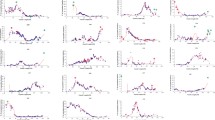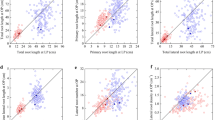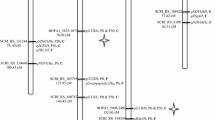Abstract
Phosphorus (P) deficiency in soils is a major limiting factor for crop growth worldwide. Changes in root morphology and architecture represent as an important mechanism of adaptation of plants to low P (LP) stress. To elucidate the genetic control of tolerance to P deficiency in Brassica napus, quantitative trait loci (QTL) for root morphology in response to LP were identified in three independent paper culture experiments, and dissected through QTL meta-analysis. In total, 62 significant QTL for total root length, root surface area, root volume, total dry weight, and plant P uptake under high and low P conditions were detected in the three experiments. Forty-five of these QTL were clustered within four linkage groups and were integrated into eight unique QTL by two rounds of QTL meta-analysis. Three of the unique QTL, uq.A1, uq.C3a and uq.C3b, were specific for LP condition. uq.C3a and uq.C3b were identified specifically for root traits and P uptake under LP stress, and may contribute to the adaptability of B. napus to P deficiency. Two functional markers, BnIPS2-C3 and BnGPT1-C3, which were developed from the genes AtIPS2 and AtGPT1 in Arabidopsis, were located in the confidence intervals of uq.C3a and uq.C3b, respectively. And AtGPT1 that corresponded to the interval of uq.C3b by in silico mapping was a possible candidate gene of uq.C3b. These results confirmed the importance of root traits for the adaptability of B. napus to LP and partially revealed the genetic basis of tolerance to P deficiency. These findings should be valuable for further study of the mechanism of P efficiency and the breeding of P-efficient cultivars by marker-assisted selection.




Similar content being viewed by others
References
Akhtar MS, Oki Y, Adachi T (2008) Intraspecific variations of phosphorus absorption and remobilization, P forms, and their internal buffering in Brassica cultivars exposed to a P-stressed environment. J Integr Plant Biol 50:703–716
Arcade A, Labourdette A, Falque M, Mangin B, Chardon F, Charcosset A, Joets J (2004) BioMercator: integrating genetic maps and QTL towards discovery of candidate genes. Bioinformatics 20:2324–2326
Batjes NH (1997) A world dataset of derived soil properties by FAO-UNESCO soil unit for global modelling. Soil Use Manage 13:9–16
Beebe SE, Rojas-Pierce M, Yan XL, Blair MW, Pedraza F, Munoz FM, Tohme J, Lynch JP (2006) Quantitative trait loci for root architecture traits correlated with phosphorus acquisition in common bean. Crop Sci 46:413-423
Bengough AG, Gordon DC, Al-Menaie H, Ellis RP, Allan D, Keith R, Thomas WTB, Forster BP (2004) Gel observation chamber for rapid screening of root traits in cereal seedlings. Plant Soil 262:63–70
Chardon F, Virlon B, Moreau L, Falque M, Joets J, Decousset L, Murigneux A, Charcosset A (2004) Genetic architecture of flowering time in maize as inferred from quantitative trait loci meta-analysis and synteny conservation with the rice genome. Genetics 168:2169–2185
Churchill GA, Doerge RW (1994) Empirical threshold values for quantitative trait mapping. Genetics 138:963–971
De Dorlodot S, Forster B, Pagès L, Price A, Tuberosa R, Draye X (2007) Root system architecture: opportunities and constraints for genetic improvement of crops. Trends Plant Sci 12:474–481
Doyle JJ, Doyle JL (1990) Isolation of plant DNA from fresh tissue. Focus 12:13–15
Duan HY, Shi L, Ye XS, Wang YH, Xu FS (2009) Identification of phosphorous efficient germplasm in oilseed rape. J Plant Nutr 32:1148–1163
Fageria NK, Baligar VC, Li YC (2008) The role of nutrient efficient plants in improving crop yields in the twenty-first century. J Plant Nutr 31:1121–1157
Hammond JP, White PJ (2008) Sucrose transport in the phloem: integrating root responses to phosphorus starvation. J Exp Bot 59:93–109
Hammond JP, Broadley MR, White PJ, King GJ, Bowen HC, Hayden R, Meacham MC, Mead A, Overs T, Spracklen WP, Greenwood DJ (2009) Shoot yield drives phosphorus use efficiency in Brassica oleracea and correlates with root architecture traits. J Exp Bot 60:1953–1968
Hermans C, Hammond JP, White PJ, Verbruggen N (2006) How do plants respond to nutrient shortage by biomass allocation? Trends Plant Sci 11:610–617
Heuer S, Lu XC, Chin JH, Tanaka JP, Kanamori H, Matsumoto T, De Leon T, Ulat VJ, Ismail AM, Yano M, Wissuwa M (2009) Comparative sequence analyses of the major quantitative trait locus phosphorus uptake 1 (Pup1) reveal a complex genetic structure. Plant Biotechnol J 7:456–471
Hoagland DR, Arnon DI (1950) The water-culture method for growing plants without soil. California Department of Agriculture experimental station circular 347, Berkeley
Holford ICR (1997) Soil phosphorus: its measurement, and its uptake by plants. Aust J Soil Res 35:227–239
Hou XL, Wu P, Jiao FC, Jia QJ, Chen HM, Yu J, Song XW, Yi KK (2005) Regulation of the expression of OsIPS1 and OsIPS2 in rice via systemic and local Pi signalling and hormones. Plant Cell Environ 28:353–364
Ismail AM, Heuer S, Thomson MJ, Wissuwa M (2007) Genetic and genomic approaches to develop rice germplasm for problem soils. Plant Mol Bio 65:547–570
Jain A, Vasconcelos MJ, Raghothama KG, Sahi SV (2007) Molecular mechanisms of plant adaptation to phosphate deficiency. In: Janick J (ed) Plant breeding reviews, vol 29. Wiley, NJ, pp 359–419
Li G, Quiros CF (2001) Sequence-related amplified polymorphism (SRAP), a new marker system based on a simple PCR reaction: its application to mapping and gene tagging in Brassica. Theor Appl Genet 103:455–461
Liao H, Rubio G, Yan XL, Cao A, Brown KM, Lynch JP (2001) Effect of phosphorus availability on basal root shallowness in common bean. Plant Soil 232:69–79
Long Y, Shi JQ, Qiu D, Li RY, Zhang CY, Wang J, Hou JN, Zhao JW, Shi L, Park BS, Choi SR, Lim YP, Meng JL (2007) Flowering time quantitative trait Loci analysis of oilseed Brassica in multiple environments and genomewide alignment with Arabidopsis. Genetics 177:2433–2444
Lowe AJ, Moule C, Trick M, Edwards KJ (2004) Efficient large-scale development of microsatellites for marker and mapping applications in Brassica crop species. Theor Appl Genet 108:1103–1112
Lynch JP (2007) Roots of the second green revolution. Aust J Bot 55:493–512
Marschner H (1995) Mineral nutrition of higher plants, 2nd edn. Academic Press, London
Neeraja C, Maghirang-Rodriguez R, Pamplona A, Heuer S, Collard B, Septiningsih E, Vergara G, Sanchez D, Xu K, Ismail A, Mackill D (2007) A marker-assisted backcross approach for developing submergence-tolerant rice cultivars. Theor Appl Genet 115:767–776
Niewiadomski P, Knappe S, Geimer S, Fischer K, Schulz B, Unte US, Rosso MG, Ache P, Flugge UI, Schneider A (2005) The Arabidopsis plastidic glucose 6-phosphate/phosphate translocator GPT1 is essential for pollen maturation and embryo sac development. Plant Cell 17:760–775
Piquemal J, Cinquin E, Couton F, Rondeau C, Seignoret E, doucet I, Perret D, Villeger MJ, Vincourt P, Blanchard P (2005) Construction of an oilseed rape (Brassica napus L.) genetic map with SSR markers. Theor Appl Genet 111:1514–1523
Qiu D, Morgan C, Shi JQ, Long Y, Liu J, Li RY, Zhuang XF, Wang YH, Tan XL, Dietrich E, Weihmann T, Everett C, Vanstraelen S, Beckett P, Fraser F, Trick M, Barnes S, Wilmer J, Schmidt R, Li JY, Li DR, Meng JL, Bancroft I (2006) A comparative linkage map of oilseed rape and its use for QTL analysis of seed oil and erucic acid content. Theor Appl Genet 114:67–80
Reymond M, Svistoonoff S, Loudet O, Nyssaume L, Desnos T (2006) Identification of QTL controlling root growth response to phosphate starvation in Arabidopsis thaliana. Plant Cell Environ 29:115–125
Schranz ME, Lysak MA, Mitchell-Olds T (2006) The ABC’s of comparative genomics in the Brassicaceae: building blocks of crucifer genomes. Trends Plant Sci 11:535–542
Shi JQ, Li RY, Qiu D, Jiang CC, Long Y, Morgan C, Bancroft I, Meng JL (2009) Unraveling the complex trait of crop yield with QTL mapping in Brassica napus. Genetics 182:851–861
Shimizu A, Yanagihara S, Kawasaki S, Ikehashi H (2004) Phosphorus deficiency-induced root elongation and its QTL in rice (Oryza sativa L.). Theor Appl Genet 109:1361–1368
Shimizu A, Kato K, Komatsu A, Motomura K, Ikehashi H (2008) Genetic analysis of root elongation induced by phosphorus deficiency in rice (Oryza sativa L.): fine QTL mapping and multivariate analysis of related traits. Theor Appl Genet 117:987–996
Shin H, Shin HS, Chen RJ, Harrison MJ (2006) Loss of At4 function impacts phosphate distribution between the roots and the shoots during phosphate starvation. Plant J 45:712–726
Solaiman Z, Marschner P, Wang D, Rengel Z (2007) Growth, P uptake and rhizosphere properties of wheat and canola genotypes in an alkaline soil with low P availability. Biol Fert Soils 44:143–153
Suwabe K, Iketani H, Nunome T, Kage T, Hirai M (2002) Isolation and characterization of microsatellites in Brassica rapa L. Theor Appl Genet 104:1092–1098
Svistoonoff S, Creff A, Reymond M, Sigoillot-Claude C, Ricaud L, Blanchet A, Nussaume L, Desnos T (2007) Root tip contact with low-phosphate media reprograms plant root architecture. Nat Genet 39:792–796
Van Ooijen JW (2006) JoinMap®4.0: software for the calculation of genetic linkage maps in experimental populations. Kyazma BV, Wageningen, Netherlands
Vance CP, Uhde-Stone C, Allan DL (2003) Phosphorus acquisition and use: critical adaptations by plants for securing a nonrenewable resource. New Phytol 157:423–447
Vos P, Hogers R, Bleeker M, Reijans M, Vandelee T, Hornes M, Frijters A, Pot J, Peleman J, Kuiper M, Zabeau M (1995) AFLP: a new technique for DNA-fingerprinting. Nucleic Acids Res 23:4407–4414
Wang SC, Bastern J, Zeng ZB (2006) Windows QTL Cartographer 2.5. Department of Statistics, North Carolina State University, Raleigh, NC, USA
Wissuwa M, Wegner J, Ae N, Yano M (2002) Substitution mapping of Pup1: a major QTL increasing phosphorus uptake of rice from a phosphorus-deficient soil. Theor Appl Genet 105:890–897
Yan XL, Liao H, Beebe SE, Blair MW, Lynch JP (2004) QTL mapping of root hair and acid exudation traits and their relationship to phosphorus uptake in common bean. Plant Soil 265:17–29
Yan XL, Wu P, Ling HQ, Xu GH, Xu FS, Zhang QF (2006) Plant nutriomics in China: An overview. Ann Bot 98:473–482
Zeng ZB (1994) Precision mapping of quantitative trait loci. Genetics 136:1457–1468
Zhang HW, Huang Y, Ye XS, Shi L, Xu FS (2009) Genotypic differences in phosphorus acquisition and the rhizosphere properties of Brassica napus in response to low phosphorus stress. Plant Soil 320:91–102
Zhao JJ, Jamar DC, Lou P, Wang YH, Wu J, Wang XW, Bonnema G, Koornneef M, Vreugdenhil D (2008) Quantitative trait loci analysis of phytate and phosphate concentrations in seeds and leaves of Brassica rapa. Plant Cell Environ 31:887–900
Zhu JM, Kaeppler SM, Lynch JP (2005a) Mapping of QTL controlling root hair length in maize (Zea mays L.) under phosphorus deficiency. Plant Soil 270:299–310
Zhu JM, Kaeppler SM, Lynch JP (2005b) Mapping of QTLs for lateral root branching and length in maize (Zea mays L.) under differential phosphorus supply. Theor Appl Genet 111:688–695
Acknowledgments
This work was supported by grants from the National Basic Research and Development Program (2005CB120905), and the National 863 High Technology Program (2006AA10A112), China. The authors sincerely thank Prof. Xiaolong Yan and Prof. Hong Liao at the Root Biology Center, South China Agricultural University, for their kind help with the paper culture technique and the data analysis with WinRHIZO. We also thank the two anonymous reviewers for critical comments and valuable suggestions for revising the paper.
Author information
Authors and Affiliations
Corresponding author
Additional information
Communicated by H. Becker.
Electronic supplementary material
Below is the link to the electronic supplementary material.
122_2010_1301_MOESM1_ESM.xls
Supplementary material 1 (XLS 136 kb)Table S1a Framework map of 176 SSR markers constructed using the Brassica napus RIL population Table S1b Linkage map of 553 molecular markers constructed using the Brassica napus RIL population
122_2010_1301_MOESM2_ESM.doc
Supplementary material 2 (DOC 58 kb) Table S2 Pearson’s correlation coefficients between traits in the Brassica napus RIL population in the three experiments under high P (HP) and low P (LP) conditions
122_2010_1301_MOESM3_ESM.doc
Supplementary material 3 (DOC 138 kb) Table S3 All significant QTL detected by the composite interval method (CIM) at high P (HP) and low P (LP) conditions in the three independent experiments
122_2010_1301_MOESM4_ESM.doc
Supplementary material 4 (DOC 41 kb) Table S4 The phenotypic values under low P condition of the RI lines with contrary genotypes at the two loci of BnIPS2-C3 and BnGPT1-C3
Rights and permissions
About this article
Cite this article
Yang, M., Ding, G., Shi, L. et al. Quantitative trait loci for root morphology in response to low phosphorus stress in Brassica napus . Theor Appl Genet 121, 181–193 (2010). https://doi.org/10.1007/s00122-010-1301-1
Received:
Accepted:
Published:
Issue Date:
DOI: https://doi.org/10.1007/s00122-010-1301-1




